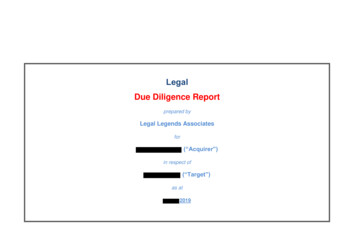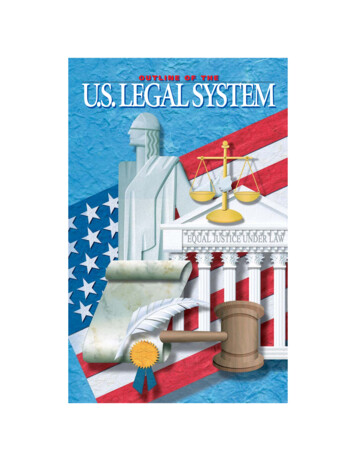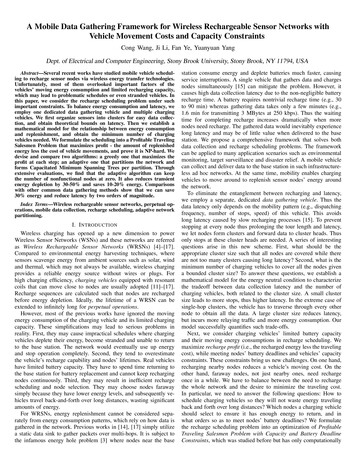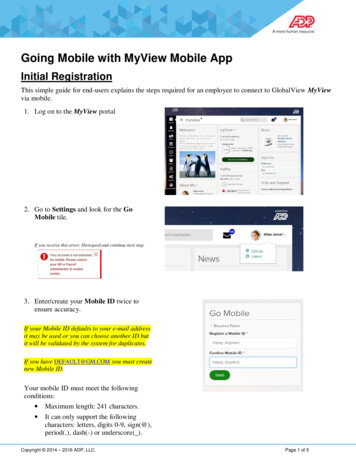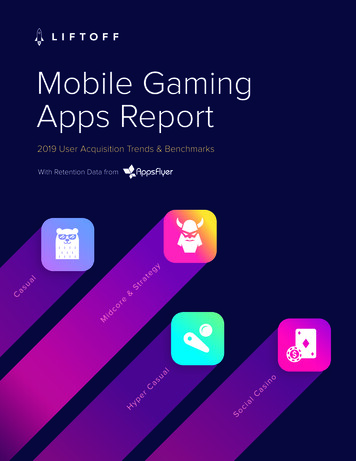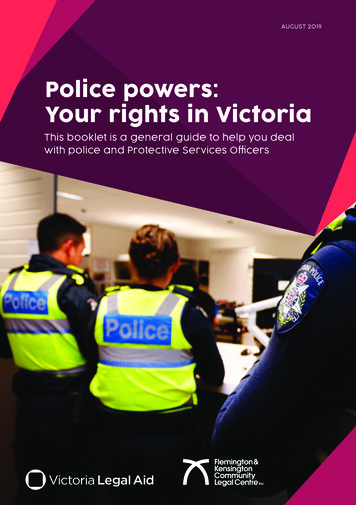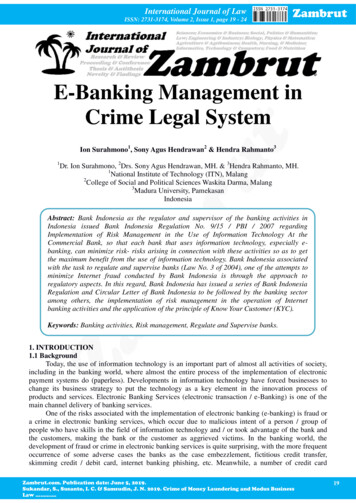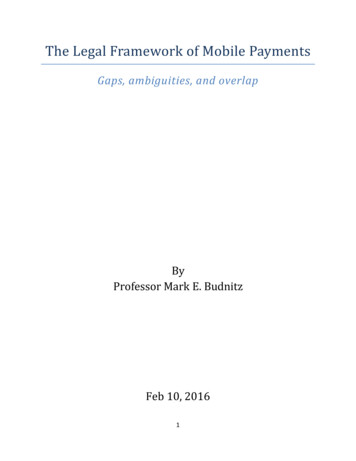
Transcription
The Legal Framework of Mobile PaymentsGaps, ambiguities, and overlapByProfessor Mark E. BudnitzFeb 10, 20161
ContentsOverview . 5Stage 1: Using mobile devices to enter into contracts for mobile payment services . 7I.Introduction . 7II. The regulatory framework . 8III.Is a mobile device a credit card? . 9IV.Is a mobile device an ‘access device’ under the EFTA?. 10V. Disclosure of mobile payments contract terms online. 11A.Credit cards . 11B.Debit cards and other electronic fund transfers . 13C.General purpose reloadable prepaid cards . 14VI.What constitutes the consumer’s acceptance of an online agreement? . 17A.Clickwrap agreements . 17B.Browsewrap agreements. 18C.Rolling contracts . 19D.Pre-dispute mandatory arbitration agreements . 21E. The law applicable to software licenses compared with other types of contracts . 22VII.Add-on services . 23VIII.Online modification of original contract terms. 23IX.Advertisements for financial services displayed on mobile device screens . 24X. Phishing scams . 24XI.Conclusion . 25Stage 2: Use of mobile device to make payments. 26I.Introduction . 26II. Mobile payment by credit card. 27III.Mobile payment by debit card . 30IV.Mobile payment by prepaid accounts and cards . 33V. Regulation of nonbanks . 34VI.Regulation of payments charged to accounts with wireless carriers . 352
VII.Authentication. 36VIII.Consumer mistakes . 37IX.Virtual currency . 38X. Children making online payments without parental consent . 39XI.Denial of service attacks. 39XII.Natural disasters . 40XIII.Payment processors . 40XIV.Third-party service providers . 41XV.Conclusion . 42Stage 3: Consumer problems after payment is made . 42I.Introduction . 42II. Consumers’ ability to stop electronic payments . 43III.Overdrafts . 47IV.Remote deposit capture. 49V. Security . 54VI.Privacy . 58VII.‘Kill switch’ laws . 63VIII.Unauthorized payments charged to consumers’ accounts with wireless carriers . 64IX.Children making mobile payments without parental consent . 66X. Insolvency and bankruptcy . 66XI.Remedies . 70A.Unauthorized use of credit and debit card accounts . 70B.Other federal and state remedies . 71C.Requiring arbitration and restricting class actions impede consumer remedies . 71XII.Conclusion . 73Options for lawmakers. 75Appendix A: Credit cards: Withholding and billing error rights under TILA . 77Appendix B: Liability for violations of TILA . 79Appendix C: Debit cards: Error resolution procedures under the EFTA . 803
Appendix D: Liability for violations of EFTA . 82Appendix E: Liability for violations of the NACHA rules . 84Appendix F: Federal laws prohibiting unfair, deceptive, and abusive acts or practices . 84Appendix G: State unfair and deceptive acts or practices statutes. 86Endnotes . 874
OverviewAs the popularity of mobile payments grows, it becomes increasingly important to understandthe legal framework in which these transactions take place. Consumers need to know theirrights and responsibilities. They need to be alert to the financial risks they are exposed to andthe legal remedies available when transactions go awry. Financial institutions and othercompanies that facilitate mobile payments need clear rules describing their obligations, rights,and liability as they develop new mobile payment products and contract with consumers formobile payment services. Finally, policymakers need to understand the impact of applicablelaws and rules on consumers and mobile payment providers so they can evaluate whether theyare adequate, and if not, what new provisions are needed.This report describes and analyzes the legal framework of mobile payments. That frameworkconsists of a wide variety of state and federal statutes, regulations, agency “guidance,” andcourt decisions. Determining which laws apply to mobile payments is complicated by severalfactors. For example, many federal agencies have regulatory, supervisory, or enforcementauthority over various aspects of mobile payments services when offered by financialinstitutions under their jurisdiction. These include the “prudential regulators,” the Office ofComptroller of the Currency, the Federal Reserve, the Federal Deposit Insurance Corp., and theNational Credit Union Administration. Companies not within legal definitions of financialinstitutions, such as PayPal and other nonbanks, are subject to the authority of the ConsumerFinancial Protection Bureau and the Federal Trade Commission. Telecommunicationscompanies are regulated by the Federal Communications Commission. State agencies, such asbank commissioners and attorneys general, enforce their laws applicable to mobile payments.A final factor making it difficult to determine which laws apply is the flood of new products andservices that the industry offers, as well as the different types of situations in which consumersmake mobile payments. For example, most consumers charge their mobile payments for goodsand services to credit cards, debit cards linked to a checking account, or prepaid card accounts.Others agree to charges being placed on their wireless carrier’s monthly bills along with thecommunications charges for using their cellphones. Entirely different laws apply depending onwhich type of account the consumer uses. Issues that arise vary significantly, from thecircumstances under which online contract provisions are enforceable to a company’s liabilityfor data security breaches and privacy invasions.1 Applicable laws range from centuries-oldcontract law and tort theories to new federal and state statutes. In some instances, no law at allapplies.5
What emerges is a patchwork of laws that is characterized to a large extent by three features:gaps (situations in which no law applies); ambiguities (where it is not clear whether a lawapplies); and overlap (where two or more laws apply to the same situation and more than oneagency has legal authority over the same type of conduct).This report describes the legal framework of mobile payments as it applies to three stages ofmobile payment transactions. The first stage is when consumers use mobile devices to enterinto contracts for mobile payment services. The second stage describes the law that applieswhen consumers use mobile devices to make payments. The final stage focuses on problemsconsumers may confront after they make mobile payments. They are referred to, respectively,as Stage 1, Stage 2, and Stage 3.After discussion of each of the stages, the report includes a conclusion section that identifiesthose gaps and ambiguities that are likely to have the greatest impact on consumers who makemobile payments because they result in mobile payment transactions being less transparentand safe.The report ends with a section that examines various policy options in light of the gaps,ambiguities, and overlap identified in the report. Each alternative has its benefits anddrawbacks. The report does not advocate any position but instead provides a legal frameworkthat may aid policymakers in making a decision on future action.6
Stage 1: Using mobile devices to enter into contracts formobile payment servicesI.IntroductionThis portion of the report describes and analyzes the regulatory framework in which mobilepayments occur. It then discusses discrete legal issues that arise when consumers enter intocontracts for mobile payment services. Topics include the legal status of the mobile device itselfwhen consumers charge their purchases to their credit or debit card accounts. The report alsoanalyzes the legal status of prepaid cards and the circumstances under which consumers agreeto legally enforceable terms in online agreements. In addition, the report examines arbitrationagreements, add-on services, advertisements on mobile device screens, and phishing scams.As described in greater detail below, there are gaps where no law applies to mobile payments,ambiguities where it is not clear how or whether current law applies, and overlap where two ormore laws may apply to the same situation or more than one government agency has authorityover a transaction.There are many gaps where no law explicitly applies to mobile payments. Examples includeissues such as whether a mobile device should be treated as legally equivalent to a credit cardor as an “access device” when a mobile payment is charged to a debit card account. Whenconsumers charge mobile payments to their credit card accounts, the federal Truth in LendingAct requires disclosures to be “conspicuous,” but that law does not explain how to apply theconspicuous standard to payments made using a mobile phone. Consumers increasingly usegeneral purpose reloadable prepaid cards when making mobile payments, but no law currentlyregulates those cards, although this may be remedied if a proposed regulation becomes law.Finally, there is a gap in the law governing software licenses. Software is not explicitly includedunder the Uniform Commercial Code (UCC), and key provisions of the UCC do not apply tolicenses.The law also is ambiguous in several respects. For example, with passage of the Dodd-FrankWall Street Reform and Consumer Protection Act (Dodd-Frank), it is no longer clear whethersome federal agencies can enforce the Federal Trade Commission Act. Consumers who agree toengage in mobile payment transactions typically enter into contracts that they consent to via anonline medium. The courts have not developed clear rules or standards for determining thecircumstances under which consumers are bound to contracts that purport to obtain theconsumer’s consent by a mere click of a mouse or the opportunity to browse on a website and7
read contract terms. The law also is ambiguous in regard to the validity of “rolling contracts,” inwhich some terms are disclosed initially and more terms are disclosed later.There is some overlap in the authority of the Consumer Financial Protection Bureau (CFPB) andthe Federal Trade Commission (FTC). Moreover, it is uncertain how far the CFPB’s supervisionwill reach. It has the legal jurisdiction to subject some companies within the mobile paymentsmarket to supervision but has not yet indicated whether it will use this authority.II.The regulatory frameworkSeveral federal agencies have authority over companies that participate in the mobilepayments environment. The agencies exercising this authority engage in one or more of thefollowing activities:(1) The agencies supervise institutions under their authority. This authority permits theagencies to demand books and records and send examiners to inspect the institutionsby visiting their offices.(2) The agencies can engage in rule-making and issue regulations. However, they canissue only regulations that a federal statute grants them the power to issue. Thestatutes most pertinent to mobile payments include the Truth in Lending Act (TILA), theElectronic Fund Transfer Act (EFTA), Dodd-Frank, and the Federal Trade Commission Act.The regulations accompanying TILA are known collectively as Regulation Z (Reg. Z), andthose accompanying the EFTA make up Regulation E (Reg. E).(3) The agencies can bring lawsuits to enforce the statutes and regulations. In thisinstance, the regulators have two options: First, they can bring an administrativeproceeding, a lawsuit heard within the agency and decided by an administrative lawjudge.2 (A company can appeal an adverse decision to a federal court.) Alternatively, theregulators can bring a lawsuit in a federal District Court.Before Dodd-Frank went into effect beginning in 2010, many of the supervision, regulation, andenforcement activities that govern mobile payments were done by “prudential” regulatoryagencies (focused primarily on the safety and soundness of banks and credit unions) that nolonger have that authority. 3 Much of it is now being done by the CFPB, but exactly whichfunctions are now subject to the CFPB’s authority varies among types of institutions. 4 Bankswith more than 10 billion in assets are subject to CFPB supervision, enforcement, and rulemaking in regard to their consumer financial services, including mobile payments. Banks withfewer assets are subject to the CFPB’s regulations. The prudential regulators still supervise8
them and enforce CFPB regulations. 5 The CFPB also has enforcement authority over the banks’third-party service providers. 6 And nonbanks are subject to the CFPB’s regulations and itsenforcement actions. In addition, payday lenders, mortgage lenders, and brokers, as well asnonbank private education lenders, are subject to CFPB supervision. Finally, the CFPB candesignate companies with revenue exceeding specified amounts in certain markets as “largerparticipants” and subject them to supervision by the CFPB. So far, debt collection, consumerreporting, student loan servicing, nonbank auto finance, and international money transfershave been identified as “larger participants.”Dodd-Frank creates an overlap in the authority of the CFPB and FTC. Both have supervisory,rule-making and enforcement authority in regard to some of the same companies when thecompanies engage in unfair or deceptive acts or practices. The two agencies have entered intoa memorandum of understanding that establishes a procedure for coordinating their activities. 7Dodd-Frank added “abusive” acts or practices to the CFPB’s arsenal but not the FTC’s.III.Is a mobile device a credit card?When consumers pay by waving their mobile device (linked to a credit card) in front of a cardreader at the point of purchase, the device transmits the credit card’s “credentials,” thepayment card account number and other information about the account, to the reader. Thequestion arises as to whether that makes the device the legal equivalent of a credit cardbecause it includes the information contained in the physical card’s magnetic stripe orcomputer chip. The law is ambiguous, since it does not mention mobile devices, but thedefinition of a credit card seems broad enough to include the devices.Reg. Z defines “credit card” to mean “any card, plate, or other single credit device that may beused from time to time to obtain credit.” 8 The official interpretation of Reg. Z provides:An account number that accesses a credit account, unless the account number canaccess an open-end line of credit to purchase goods or services, [is not a credit card].For example, if a creditor provides a consumer with an open-end line of credit that canbe accessed by an account number in order to transfer funds into another account, the account number is not a credit card. However, if the account number can alsoaccess the line of credit to purchase goods or services (such as an account number thatcan be used to purchase goods or services on the Internet), the account number is acredit card. 99
In other words, the crucial requirement for constituting a credit card is not a physical card at all.The 4th U.S. Circuit Court of Appeals stated it this way: The “core element of a ‘credit card’ isthe account number, not the piece of plastic.” 10This definition of credit card has implications for mobile payments. Wh
contracts for mobile payment services. Topics include the legal status of the mobile device itself when consumers charge their purchases to their credit or debit card accounts. The report also analyzes the legal status of prepaid cards and the circumstances under which consumers agree to legally enforceable terms in online agreements.
